
| home | catalogue | history | references | appendix |
 |
surfresearch.com.au
references
: books : j
|
| a |
|
|
|
|
|
|
|
|
|
|
|
|
|
|
|
|
|
|
|
|
|
|
|
|
|
| 1963 Jackson, Gainor W.: The Australian Beach and Boating Book. Cassell Australia, 210 Queen Street Melbourne, Victoria, 1963. Hard cover, 127 pages, black and white illustrations, Index. Review Basic instructional book for beachgoers, with a major focus on boating. See Source Documents
|
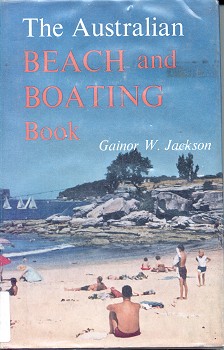 |
Eight-oared shell (modern
rowing boat)
Dating back to 1855 when this
keelless eight-oared racing boat made its appearance at
Henley on
Thames.
Designed by Matthew Taylor, for
the Royal Rowing Club, it was built, with an outer skin of
bent or
moulded cedar wood, bottom side
upwards on the moulds.
Ribs were fitted inside the
skin after the boat had been reversed.
Oxford University launched a
similar craft of their own, at Putney in 1857, 63 feet in
length and 25
inches in beam.
Over the years the dimensions
and fittings varied but these were prototypes for most
racing boats
into the 20th century and is
used in the University Boat Race crewed by a coxed eight.
Hulls were made of cedar wood
imported from Central America which although only three
sixteenths
of an inch thick could
withstand pressures of 8,000 pounds below the waterline.
During the 1970s experiments
were made with fibreglass, and other materials, which has
led to the
modern rowing eight and the
four which now dominate the sport..
http://easyweb.easynet.co.uk/jim.shead/Boats4.html
For the boardrider, Chris Cornick's
essay Cactus Beach, page 233, has particular resonance.
Cornick records two SLSA Meritorious
Awards for rescuing victims of shark attacks and in both cases
the victims were fellow club members and the rescue used a
surfboard.
At Fairhaven, Victoria in 1959,
Russell Hughes positioned an injured Chris Holland, who was body
surfing, on his balsawood pig board and swam him back to the
beach.
Hughes and his board(s) are shown on
page 237.
In 2000 Steve Thomas of Glenelg SLSC
and ex-member Anthony Hayes were boardriding at Cactus Beach,
South Australia, when Hayes was attacked by a three metre bronze
whaler.
Thomas fought off the shark and
paddled Hayes and the boards back to the beach, applied first
aid, and drove 25 kilometres to meet an ambulance dispatched
from Ceduna.
These cases are certainly extreme
situations, however many experienced boardriders have stories of
rescues they have performed, invariably unrecorded by officials
or the press.
While the SLSA has been unscrupulous
in collating rescue data, the number of unofficial recues
carried out by recreational boardriders is, by definition,
unknown but likely to be substantial.
| 1998 James, Don Surfing San Onofre to Point Dume 1936-1942 Photographs by Don James Chronicle Books 85 Second Street, San Francisco, CA 94105, 1998. First published 1996 by Tom Adler Books, Santa Barbara, CA Hard cover, 140 pages,10 colour plates, 104 black and white plates, Introduction by C. R. Stecyk, Notes. Review A excellently produced volume of photographs from a golden era of surfing that set the style for the coming popular surf culture. Design Note : There are no reconisable fins on these boards but several examples of a keel type attachment, approximately 2 1/2 inches by 8 inch base. Plates : page 12; two boards, right page 39; page 115. Performance Note : Despite constant references to the solid wood era surfers as riding straight to the beach, these photographs emphatically show this is not the case. In most photographs the surfer is cutting left or right. Also see 1941 Click : Surfboards Ahoy!, California. Text and photographs (by Dr. Don James) from Click, August 1941. |
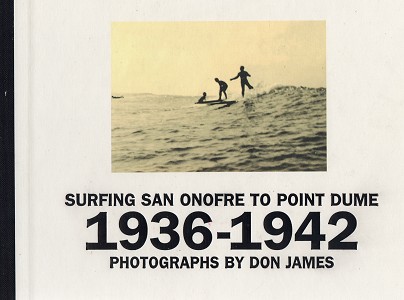 |
| 1985 Jarratt, Phil and Edwards, Tony The Surfing Dictionary Sun Books The Macmillan Company of Australia Pty Ltd 107 Moray Street, South Melbourne 3205 6 Clarke Street, Crows Nest 2065, 1985. Soft cover, 84 pages, 50 black and white illustrations. Review Humorous surfing definitions by Phil Jarratt (see Tracks magazine and other works on this page) and even better illustrations by Tony 'Captain Goodvibes' Edwards. Fin - The short, sharp object attached to the bottom of the board designed to maim or decapitate wayward bobysurfers. As the bodysurfer problem has increased, so has the number of weapons employed on each board. As many as five are considered necessary on summer Sundays at places like Bondi. - page 22. |
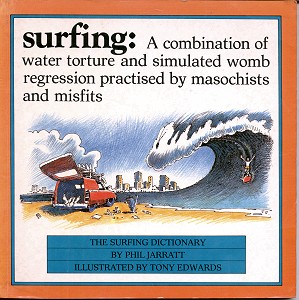 |
| 1997 Jarratt, Phil : Mr. Sunset – The Jeff Hakman Story Gen X Publishing, Park Place, Canary Wharf, London, E144HJ, United Kingdom, 1997. Hard cover, 192 pages, 130 colour photographs, 72 b/w photographs, 11 newspaper / magazine reproductions, cast update. Review Beautifully produced work (John Witzig), well written and with excellent photographs. Strong on Australian content, likewise drug abuse. Phil Jarrartt is a former editor of Tracks magazine. |
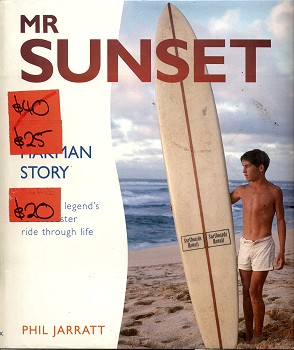 |
| 2010 Jarratt, Phil : Salts and Suits - How a bunch of surf bums created a multi-billion dollar industry ... and almost lost it. Hardie Grant Books 85 High Street Prahan, Victoria, 3181, Australia, 2010. Soft cover, 265 pages, colour and black and white plates, Where are they now?, Acknowledgements, Glossary, Index. Review Expansive and indepth account of the rise of the major Australian based surf fashion companies by former Tracks magazine editor and industry employee, Phil Jarrartt. The first six chapters are an historical overview of the expansion of surfing from its Polynesian roots up to the end of the 1960s. Regretably these are not flawless - note, for example, another repitition of the Gocher myth (page 27) and Jarratt's apparent confusion between Cook's mariner William Ellis (died 1785) and the missionary Rev. William Ellis (1789-1872), pages 12 and 13. As the book progresses it becomes more involved with the development of ever increasing complex business models and corresponding intricate boardroom politics. This copy provided courtesy of Paul Flack. |
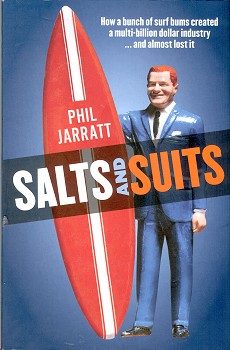 |
| 2014
Jarratt, Phil : Bali: Heaven and Hell Hardie Grant Books (Australia) Ground and Level One Building One 658 Church Street Richmond, 3121, 2014. www.hardiegrant.com Soft cover, 334 pages, black and white and colour plates, End Notes, Acknowledgements, Index. Review An expansive history of Bali focusing on its development as a world-wide renown tourist destination, including the impact of visiting surfers. |
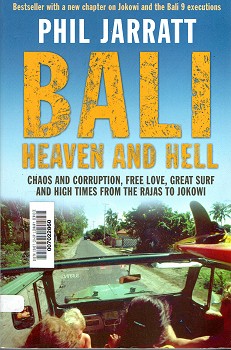 |
| 2017 Jarratt, Phil: Life of Brine: A Surfer's Journey Hardie Grant Books (Australia) 658 Church Street Richmond, 3121, 6 June 2017. Paperback, 287 pages, black and white photographs, Acknowledgements. Review An delightfully honest and highly readable autobiography by Phil Jarratt, one time editor of Tracks and California's Surfer magazine. Plenty of unique personalities, waves, drugs and sex. |
 |
| 1999 Jenkins, Bruce : North Shore Chronicles : Big Wave Sufing in Hawaii - Revised Edition Frog Ltd , Berkley, California Distributed by North Atlantic Books PO Box 12327, Berkley, California, 94712, 1999. Soft cover, 195 pages, 65 colour photographs, 15 black and white photographs. Review Second edition updates the previous work with additional chapters detailing the development of tow in surfing (Big Wednesday -page 177) and the death of Mark Foo (The Last Wave - page 191). The photograph selection has been updated. |
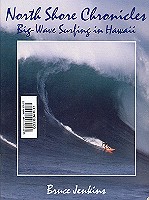 |
| 2015 Jha, Alok: The Water Book : the extraordinary story of our most ordinary substance. Headline, London, 2015.
Soft cover, 376 pages, maps. Review. Water is a remarkable substance, essential to carbon-based life forms, and there is a lot of it in the cosmos. Water molecules helped create the Earth, life on it and us. We have built our worlds, and we are ourselves built of this remarkable substance. Jha’s book is often remarkable, too. t is overlong; in places it needed more zealous editing. But it holds wonders enough that you can swim through the flaws, and into its deeps. - Rose George http://www.theguardian.com/books/2015/the-water-book-by-alok-jha-review |
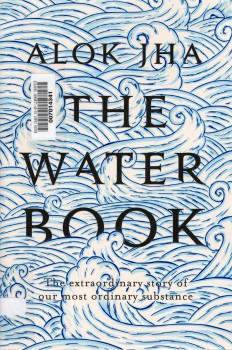 |
| 1963 Johnson, Barry : Surf Fever The Jacaranda Press, Brisbane, 1963. Soft cover, 32 pages, black and white photographs and illustrations, Glossary. Review A basic introductory book with a considerable focus on Queensland's Gold Coast, unlike most o f the early literature which tends to be Sydney based. Of most interest is the chapter on How a Board is Made, pages 13 to 16, with accompanying photographs from Joe Larkin's Coolangatta factory. The photographs are probably not in the correct sequence. The illustrator is not accredited. See Source Documents:
|
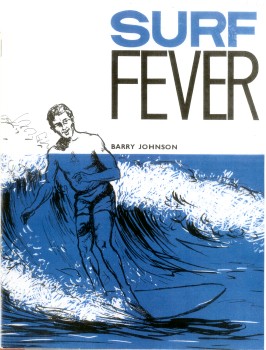 |
| a |
|
|
|
|
|
|
|
|
|
|
|
|
|
|
|
|
|
|
|
|
|
|
|
|
|

| home | catalogue | history | references | appendix |